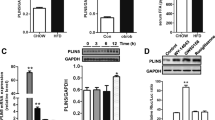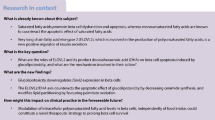Abstract
Lipotoxicity-induced pancreatic β cell damage is a strong predictor of type 2 diabetes mellitus (T2DM). Our previous work showed that Caveolin-1 (Cav-1) depletion decreased β-cell apoptosis and improved β-cell viability. Further microarray analysis indicated significant changes in the expression of genes related to fatty acid metabolism and inflammation. The objective of this study was to explore the role of Cav-1 in intracellular lipid accumulation and inflammation in β cells under lipotoxic conditions. Here, we established a β-cell-specific Cav-1 knockout (β-Cav-1 KO) mouse model and a CAV-1 depleted β cell line (NIT-1). We found that Cav-1 silencing significantly reduced palmitate (PA)-induced intracellular triglyceride (TG) accumulation and decreased proinflammatory factor expression in both the mouse and cell models. Further mechanistic investigation revealed that amelioration of lipid metabolism was achieved through the downregulation of lipogenic markers (SREBP-1c, FAS and ACC) and upregulation of a fatty acid oxidation marker (CPT-1). Meanwhile, decrease of inflammatory cytokines (IL-6, TNF-α, and IL-1β) secretion was found with the involvement of the IKKβ/NF-κB signaling pathways. Our findings suggest that Cav-1 is of considerable importance in regulating lipotoxicity-induced β-cell intracellular lipid accumulation and inflammation.








Similar content being viewed by others
Data availability
The data are available from the corresponding author on reasonable request.
References
Varshney R, Gupta S, Roy P (2017) Cytoprotective effect of kaempferol against palmitic acid-induced pancreatic β-cell death through modulation of autophagy via AMPK/mTOR signaling pathway. Mol Cell Endocrinol 448:1–20
Goh TT, Mason TM, Gupta N, So A, Lam TK, Lam L, Lewis GF, Mari A, Giacca A (2007) Lipid-induced beta-cell dysfunction in vivo in models of progressive beta-cell failure. Am J Phys Endocrinol Metab 292(2):E549–E560
Wilding JP (2007) The importance of free fatty acids in the development of type 2 diabetes. Diabetic Medicine : a journal of the British Diabetic Association 24(9):934–945
Giacca A, Xiao C, Oprescu AI, Carpentier AC, Lewis GF (2011) Lipid-induced pancreatic β-cell dysfunction: focus on in vivo studies. Am J Phys Endocrinol Metab 300(2):E255–E262
Butler AE, Janson J, Bonner-Weir S, Ritzel R, Rizza RA, Butler PC (2003) Beta-cell deficit and increased beta-cell apoptosis in humans with type 2 diabetes. Diabetes 52(1):102–110
Khin PP, Lee JH, Jun HS (2021) A brief review of the mechanisms of β-cell dedifferentiation in type 2 diabetes. Nutrients 13(5):1593
Quest AF, Leyton L, Párraga M (2004) Caveolins, caveolae, and lipid rafts in cellular transport, signaling, and disease. Biochemistry and cell biology =. Biochimie et Biologie Cellulaire 82(1):129–144
Zhang C, Wu Q, Huang H, Chen X, Huang T, Li W, Liu Y, Zhang J (2019) Caveolin-1 promotes Rfng expression via Erk-Jnk-p38 signaling pathway in mouse hepatocarcinoma cells. J Physiol Biochem 75(4):549–559
Chen X, Wang L, Wu Y, Zhang H, Dong W, Yu X, Huang C, Li Y, Wang S, Zhang J (2022) Caveolin-1 knockout mice have altered serum N-glycan profile and sialyltransferase tissue expression. J Physiol Biochem 78(1):73–83
Lillo Urzúa P, Núñez Murillo O, Castro-Sepúlveda M, Torres-Quintana MA, Lladser Caldera Á, Quest AFG, Espinoza Robles C, Llanos Vidal P, Wehinger S (2020) Loss of Caveolin-1 is associated with a decrease in Beta cell death in mice on a high fat diet. Int J Mol Sci 21(15):5225
Wehinger S, Ortiz R, Díaz MI, Aguirre A, Valenzuela M, Llanos P, Mc Master C, Leyton L, Quest AF (2015) Phosphorylation of caveolin-1 on tyrosine-14 induced by ROS enhances palmitate-induced death of beta-pancreatic cells. Biochim Biophys Acta 1852(5):693–708
Yamamoto M, Toya Y, Schwencke C, Lisanti MP, Myers MG Jr, Ishikawa Y (1998) Caveolin is an activator of insulin receptor signaling. J Biol Chem 273(41):26962–26968
Strålfors P (2012) Caveolins and caveolae, roles in insulin signalling and diabetes. Adv Exp Med Biol 729:111–126
Haddad D, Al Madhoun A, Nizam R, Al-Mulla F (2020) Role of Caveolin-1 in diabetes and its complications. Oxidative Med Cell Longev 2020:9761539
Zeng W, Tang J, Li H, Xu H, Lu H, Peng H, Lin C, Gao R, Lin S, Lin K, Liu K, Jiang Y, Weng J, Zeng L (2018) Caveolin-1 deficiency protects pancreatic β cells against palmitate-induced dysfunction and apoptosis. Cell Signal 47:65–78
Sun X, Ji G, Li P, Li W, Li J, Zhu L (2021) miR-344-5p modulates cholesterol-induced β-cell apoptosis and dysfunction through regulating Caveolin-1 expression. Front Endocrinol 12:695164
Li H, Peng H, Xu H, Xu F, Lin S, Lin K, Zeng W, Zeng L (2018) The effects of caveolin1 on β cell proliferation. Cell Mol Biol (Noisy-le-Grand, France) 64(1):40–46
Peng H, Mu P, Li H, Lin S, Lin C, Lin K, Liu K, Zeng W, Zeng L (2021) Caveolin-1 is essential for the improvement of insulin sensitivity through AKT activation during glargine treatment on diabetic mice. J Diabetes Res 2021:9943344
Marchetti P, Lupi R, Del Guerra S, Bugliani M, Marselli L, Boggi U (2010) The beta-cell in human type 2 diabetes. Adv Exp Med Biol 654:501–514
Vernier S, Chiu A, Schober J, Weber T, Nguyen P, Luer M, McPherson T, Wanda PE, Marshall CA, Rohatgi N, McDaniel ML, Greenberg AS, Kwon G (2012) β-Cell metabolic alterations under chronic nutrient overload in rat and human islets. Islets 4(6):379–392
Wang D, Tian M, Qi Y, Chen G, Xu L, Zou X, Wang K, Dong H, Lu F (2015) Jinlida granule inhibits palmitic acid induced-intracellular lipid accumulation and enhances autophagy in NIT-1 pancreatic β cells through AMPK activation. J Ethnopharmacol 161:99–107
Razani B, Combs TP, Wang XB, Frank PG, Park DS, Russell RG, Li M, Tang B, Jelicks LA, Scherer PE, Lisanti MP (2002) Caveolin-1-deficient mice are lean, resistant to diet-induced obesity, and show hypertriglyceridemia with adipocyte abnormalities. J Biol Chem 277(10):8635–8647
Siddiqi S, Sheth A, Patel F, Barnes M, Mansbach CM 2nd (2013) Intestinal caveolin-1 is important for dietary fatty acid absorption. Biochim Biophys Acta 1831(8):1311–1321
Fernández-Real JM, Catalán V, Moreno-Navarrete JM, Gómez-Ambrosi J, Ortega FJ, Rodriguez-Hermosa JI, Ricart W, Frühbeck G (2010) Study of caveolin-1 gene expression in whole adipose tissue and its subfractions and during differentiation of human adipocytes. Nutr Metab 7:20
Qiu Y, Liu S, Chen HT, Yu CH, Teng XD, Yao HT, Xu GQ (2013) Upregulation of caveolin-1 and SR-B1 in mice with non-alcoholic fatty liver disease. Hepatobiliary & Pancreatic Diseases International : HBPD INT 12(6):630–636
Cohen AW, Razani B, Schubert W, Williams TM, Wang XB, Iyengar P, Brasaemle DL, Scherer PE, Lisanti MP (2004) Role of caveolin-1 in the modulation of lipolysis and lipid droplet formation. Diabetes 53(5):1261–1270
Pezeshkian W, Chevrot G, Khandelia H (2018) The role of caveolin-1 in lipid droplets and their biogenesis. Chem Phys Lipids 211:93–99
Kuo A, Lee MY, Yang K, Gross RW, Sessa WC (2018) Caveolin-1 regulates lipid droplet metabolism in endothelial cells via autocrine prostacyclin-stimulated, cAMP-mediated lipolysis. J Biol Chem 293(3):973–983
Hardie DG (2004) AMP-activated protein kinase: a master switch in glucose and lipid metabolism. Rev Endocr Metab Disord 5(2):119–125
Wang Q, Liu S, Zhai A, Zhang B, Tian G (2018) AMPK-mediated regulation of lipid metabolism by phosphorylation. Biol Pharm Bull 41(7):985–993
Tong X, Liu S, Stein R, Imai Y (2022) Lipid Droplets' role in the regulation of β-cell function and β-cell demise in type 2 diabetes. Endocrinology 163(3):bqac007
Kharroubi I, Ladrière L, Cardozo AK, Dogusan Z, Cnop M, Eizirik DL (2004) Free fatty acids and cytokines induce pancreatic beta-cell apoptosis by different mechanisms: role of nuclear factor-kappaB and endoplasmic reticulum stress. Endocrinology 145(11):5087–5096
Bae GD, Park EY, Kim K, Jang SE, Jun HS, Oh YS (2019) Upregulation of caveolin-1 and its colocalization with cytokine receptors contributes to beta cell apoptosis. Sci Rep 9(1):16785
Veluthakal R, Chvyrkova I, Tannous M, McDonald P, Amin R, Hadden T, Thurmond DC, Quon MJ, Kowluru A (2005) Essential role for membrane lipid rafts in interleukin-1beta-induced nitric oxide release from insulin-secreting cells: potential regulation by caveolin-1+. Diabetes 54(9):2576–2585
Kitahara A, Takahashi K, Morita N, Murashima T, Onuma H, Sumitani Y, Tanaka T, Kondo T, Hosaka T, Ishida H (2017) The novel mechanisms concerning the inhibitions of palmitate-induced Proinflammatory factor releases and endogenous cellular stress with Astaxanthin on MIN6 β-cells. Mar Drugs 15(6):185
Acknowledgements
We thank Dr. Jiansong Tang for editing and critically revising this manuscript.
Funding
This work was supported by the National Natural Science Foundation of China (grant numbers: 81070661 and 51873071), the Natural Science Foundation of Guangdong Province (grant number: 2018B030311012), the Medical Scientific Research Foundation of Guangdong Province (grant number: A2021168), the Science and Technology Planning Project of Guangzhou (grant number: 202102010146) and the Science and Technology Planning Project Fundamental and Applied Fundamental Research Topics of Guangzhou (assignment number: 2023A04J1088).
Author information
Authors and Affiliations
Contributions
Wen Zeng wrote the manuscript. Wen Zeng and Nan Cai organized the literature and figures. Wen Zeng, Nan Cai, Jia Liu and Kunying Liu performed the experiments. Shuo Lin and Longyi Zeng conceived the project, led and supervised the study, and reviewed/edited the manuscript. Wen Zeng and Nan Cai contributed to this study equally. The authors declare that all data were generated in-house and that no paper mill was used.
Corresponding authors
Ethics declarations
Consent for publication
All authors approved the version to be published.
Research involving human participants and/or animals
This manuscript does not contain clinical studies or patient data. All of the animal procedures were carried out in accordance with National Institutes of Health guidelines and approved by the Institute Animal Care and Use Committee (IACUC) at the Animal Ethics Committees of the Sun Yat-Sen University.
Competing interests
The authors declare no competing interests.
Additional information
Publisher's Note
Springer Nature remains neutral with regard to jurisdictional claims in published maps and institutional affiliations.
Key points
• β-cell-specific CAV-1 knockout decreased blood lipid levels in HFD-fed mice and downregulated the expression of inflammatory mediators in PA-treated β cells.
• The reduction in intracellular lipid accumulation by Cav-1 depletion was found to occur through the inhibition of lipogenesis-related gene expression and facilitation of lipolysis-related gene expression.
• The suppression of the inflammatory response after Cav-1 depletion was found to involve the IKKβ/NF-κB signaling pathway.
Supplementary Information
Below is the link to the electronic supplementary material.

Rights and permissions
Springer Nature or its licensor (e.g. a society or other partner) holds exclusive rights to this article under a publishing agreement with the author(s) or other rightsholder(s); author self-archiving of the accepted manuscript version of this article is solely governed by the terms of such publishing agreement and applicable law.
About this article
Cite this article
Zeng, W., Cai, N., Liu, J. et al. Caveolin-1 deficiency alleviates palmitate-induced intracellular lipid accumulation and inflammation in pancreatic β cells. J Physiol Biochem 80, 175–188 (2024). https://doi.org/10.1007/s13105-023-00995-9
Received:
Accepted:
Published:
Issue Date:
DOI: https://doi.org/10.1007/s13105-023-00995-9




